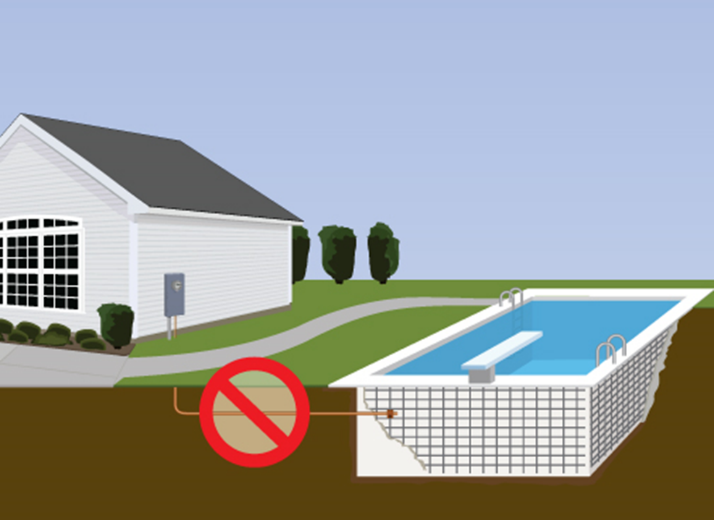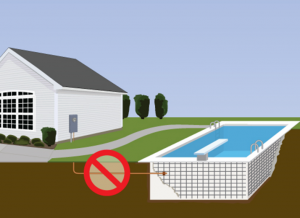Grounding Electrodes – to be or not to be? 2017 NEC 250.52(B)(3)

By: Robert Key | Sep 26, 2019
Prior to 2017, only two items were prohibited for use as grounding electrodes: underground gas piping and aluminum. For 2017, another item has been added to the list of prohibited items. For the 2017 NEC Code cycle, the structures as well as steel reinforcement materials that pertain to swimming pools have been added to the list found in 250.52(B)(3) of components that are prohibited from being used as grounding electrodes for an electrical system. We know that aluminum decomposes when in direct contact with the earth, and underground gas piping is prohibited due to the flammable gas it carries. But why is the equipotential bonding grid and structural reinforcing steel described at 680.26(B)(1) and (B)(2) now prohibited from being used as a grounding electrode? To answer this question, we must examine the intended purpose of the grounding electrode versus the purpose of the equipotential bonding that is required in swimming pool installations.
The equipotential bonding specified at 680.26(B)(1) and (B)(2) has a purpose- to equalize the voltage potential in the vicinity of the pool. We will not venture into a discussion of equipotential planes here, as that is a complicated subject that deserves its own article. However, the grounding electrode system serves a very different purpose. The terms “grounding” and “bonding” are sometimes used interchangeably, but they are not the same. The grounding electrode was adopted between the 1950s and 1970s, depending on your area of the Country, and was introduced to divert lightning strikes away from utility company owned transformers. The grounding electrode plays no part in causing a circuit-breaker to trip during a short to ground condition on a branch-circuit. The grounded neutral conductor (connected by way of a main bonding jumper to the enclosure of the first grounding electrode means of disconnect) allows this to happen. Stray currents follow this same grounded conductor back to the utility transformer. The grounding electrode is solely provided to draw lightning and any other unintended voltages on the electrical system to the earth, where it can be carried away from the system.
There is, however, a much more compelling reason not to connect the bonding grid to the grounding electrode system. Using any in-ground metal that is associated with a swimming pool as part of the grounding electrode system could introduce current from the electrical system into the earth near the swimming pool. In addition to this, lighting strikes or unintentional contact between high-voltage lines may result in temporary currents on the grounding electrode system conductors. If the pool metal is a part of this, we are just asking for trouble. This is the reason that it has been prohibited from being used as a grounding electrode conductor.
Here is the new 2017 Code language found at 250.52(B):
Not Permitted for Use as Grounding Electrodes. The following systems and materials shall not be used as grounding electrodes:
(1) Metal underground gas piping systems
(2) Aluminum
(3) The structures and structural reinforcing steel described in 680.26(B)(1) and (B)(2)
When we consider the very different function and purpose of the grounding electrode versus the bonding of the parts specified in 680.26(B)(1) through (B)(7), it is apparent that to connect this intentional current carrying system to underground pool metal would be a bad idea. The language found at 680.26(B) further clarifies that the bonding grid should not be connected to the grounding system. It states: An 8 AWG or larger solid copper bonding conductor provided to reduce voltage gradients in the pool area shall not be required to be extended or attached to remote panelboards, service equipment, or electrodes. Some might have argued in the past that 250.52(A)(8), which includes as possible electrode choices Other local metal underground systems or structures such as piping systems, underground tanks, and underground metal well casings that are not bonded to a metal water pipe, gives permission to use the pool steel as a grounding electrode. Thankfully, the new Code language at 250.52(B)(3) makes it clear that the reinforcing steel or bonding grid associated with a pool is not to be used as a grounding electrode. It is an important code change that could potentially save lives.



Not sure I understand what is being said here. Does this mean that the metal parts around a pool are not connected to any of the electrical equipment I may have jumped the gun by writing this now. I will get my code book tomorrow and read more about it. Thank You!!!
I know there’s a bonding system including a bronze junction box near my concrete pool. and I know there is a grounding conductor from the pool’s sub panel back to the main. I dont yet understand how stray currents are taken back to the pool sub panel.